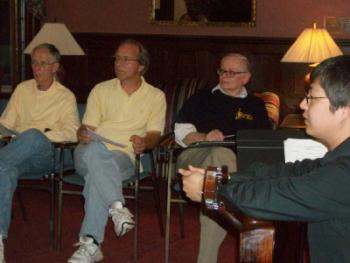Sungmin Shin’s Presentation “Fretboard Frontiers: Exploring Scales and Modes” in the Red Room, Monday, September 17, 2012
Sungmin Shin began his well organized and enthusiastic presentation for RGC on January 16 this year with his discourse on “Chords and Voicings Made Simple” and continued this Monday, September 17 with his informative “Fretboard Frontiers: Exploring Scales and Modes.” Enthusiastic RGC guitarists once again followed him through the complex world of the guitar fretboard exploring the patterns that scales and modes create.

Sungmin Shin on Scales
Sungmin eased us into the session with a gentle performance of his original “Whispers,” one of many pieces he has written for students. Appropriately, this piece features changes of mood based on modes and arpeggios.
We then continued with a lively discussion of the nature and value of scales. All agreed that scales are the building blocks of harmony and essential for structuring chords, all of which leads us into a better knowledge of the fretboard. Scales are the building blocks of harmony, and a knowledge of them helps us to learn music more quickly while building our technique as we become more familiar with the fretboard. Scales are the vocabulary of music.
Sungmin accompanied his discussion with a concise presentation in his handout which is now available on this website on the Resources page. It includes the structure of major scales, minor scales, keys, finger patterns on the fretboard and modes in parallel and relative relationships.

RGC Guitarists with Sungmin
Scales are built on a series of whole tones and semitones with major scales having semitones after the third and seventh scale degrees. Every type of scale and mode has its own unique pattern of semitones and whole tones. On a piano, this is more obvious with the black keys being the flats and sharps in between the whole tones. The white keys without black keys between them are where the semitones lie. On the guitar, this may not be as obvious, but an examination of a single string shows that each fret is equivalent to a half tone, and thus the same pattern can be found following the string up the neck. Confusion arises when we cross over the six strings to find the notes with minimal hand motion, and this is exactly where we need to begin learning finger patterns.
The various types of minor scales: natural, melodic and harmonic with their distinct patterns of semi and whole tones were briefly discussed. Since a scale can be constructed based on any of twelve notes, there is a major and minor scale in every key with a unique number of sharps or flats. There are various ways to keep track of all this, mentally or with printed guides such as Sungmin’s handout. Each finger pattern can be moved up and down the fretboard creating all the scales depending on the starting point. Five different shapes are presented with the root notes being indicated by larger dots.
A very helpful exercise is to find each note everywhere it lies on the guitar. Thorough fretboard knowledge comes slowly and steadily. The brain may think fast, but muscle memory develops slowly. It is a tedious process, but over time patterns become familiar allowing for more fluency and easier improvisation.
It is a good idea to learn these patterns by ear as well as from the written page. Sight reading is a traditional weakness of guitarists, but learning the fretboard provides the basis for freedom of the frets. It is also helpful to start our study in the key of C with no sharps or flats and proceed from there. Knowing the location of the natural notes, it is not hard to find the accidentals. Together, we worked through the key of C beginning at the fifth fret.
Modes are built on different interval patterns than the major and minor keys, but the major scale corresponds to the Ionian mode while the natural minor scale is equivalent to the Aeolian mode. Each mode seems to have its own characteristic mood from jazzy to Spanish. Modal music tends to deviate less from its scale notes than does tonal music. Parallel modes are all the modes based on the same root, each with its own key signature and name. Relative modes all have the same key signature, but each starts on a different root.
To illustrate the effect of modes, Sungmin suggested that one of the participants play a solo in the key of “C” ascending and descending while he accompanied him in different modes This procedure seemed to change the feeling of the solo as it progressed although it was always the same. To the satisfaction of all present, Sungmin concluded this complex presentation in a relaxing mood with an original piece in “E” Aeolian in 7/8 time.
~R. Taglieri
Share this page: ![]() Facebook
Facebook
![]() Del.icio.us
Del.icio.us
![]() StumbleUpon
StumbleUpon
![]() Digg
Digg
![]() Reddit
Reddit
Home ::
About Us ::
Events ::
Articles ::
Resources ::
Contact Us ::
Links
©2007-2012, Rochester Guitar Club, All Rights Reserved, This page last updated 2013-11-13 11:05:08
Website by Red Beagle Web Development.








